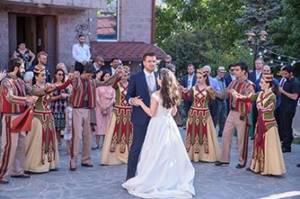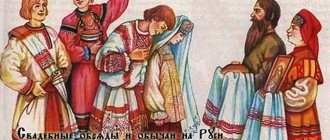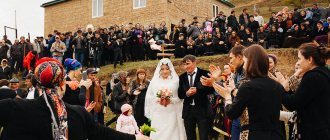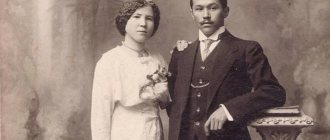A traditional Armenian wedding is considered one of the most hospitable, crowded and fun. It is not for nothing that it is believed that among all wedding ceremonies the most beautiful is the Armenian wedding. Of course, modernity has influenced the wedding customs of all nations, including the Armenian. However, despite this, centuries-old traditions carefully preserve all the nuances of this important, solemn and numerous holiday.
On the topic of the article: features of an Orthodox wedding.
So we can confidently say that the traditions of holding all stages of an Armenian wedding have remained virtually unchanged. If you are marrying an Armenian, you need to not only know, but also strictly observe all the rules and customs that dictate how a wedding should take place in Armenia.
Matchmaking
An intermediary called midjnord kin (in our opinion, this is a matchmaker) is sent to the bride’s house. This should be a respected woman from the young man’s family, sometimes the groom’s mother acts as an intermediary. Moreover, it should be familiar to the parents of the future bride. Before coming to matchmaking, the intermediary comes to visit the girl and tries to find out from the parents through hints how they feel about their daughter’s upcoming marriage.
After this, matchmakers from among the young man’s relatives are sent to the bride. Negotiations should take place only with the participation of men. The matchmakers voice the reason for the visit and ask for the girl's hand in marriage. The girl's father may hint about consent or refuse the matchmakers in a veiled form. The bride's father gives consent only during the second matchmaking: it is believed that by quickly agreeing to the marriage, relatives are trying to get rid of the girl as quickly as possible. During the second visit of the matchmakers, the details of the next step - engagement - are discussed.
Modern traditions
Of course, the modern world has greatly simplified wedding traditions. Of course, the scope for a city resident still remains excessively large; Armenians also wear a wedding ring on their left hand, but, for example, the tradition of hiding the bride can now only be found in the outback.
It has been slightly reborn and acquired a new form, the tradition of bride kidnapping . If some guy wants to marry a girl, however, her parents are against the union, he can simply stuff his beloved into the car and take her to his place. A day later, his parents call or otherwise contact the bride's father and mother and offer to marry her to their son. Since Armenians have a very scrupulous attitude towards chastity, they have no choice but to agree, because the girl’s reputation has already suffered, and there will be no one willing to marry her.
The girl, willy-nilly, had to marry her kidnapper. Whatever the reason for the abduction, the parents' disagreement or the girl's opinion, she was always treated with respect during this time. From the outside it might seem that she was simply being carried in her arms. Although in the modern world, thefts are common only in the provinces, because what kind of guy would kidnap a girl in a city where her parents can immediately report it to the police.
“Engagement” or betrothal in Armenia
The wedding custom of betrothal among Armenians speaks of the beginning of close relationships between related families. On the agreed day, future relatives first come to the groom's house. Relatives from the young man’s side prepare gifts (treats, jewelry, etc.). During the feast, Armenian wedding toasts are made, and those gathered wish the newlyweds a happy life and a strong family. The feast in the groom's house is short, then the guests go to the bride's house, where the festive table is also set.
According to Armenian custom, the kavor (or planted father) is the most significant figure at an Armenian wedding. This could be the groom's godfather or another respected man who is a relative on the groom's side. Cavor leads the bride and her friends to the table, where the future young wife is given jewelry. Then the kavor says that the engagement has taken place, and the groom puts a ring decorated with a stone on the bride’s ring finger of her left hand. During the engagement, the wedding date, the bride’s dress and other attributes characteristic of an Armenian wedding are chosen. In the bride's house on the day of engagement, sad melodies are heard, in which the future young wife is sad that she has to leave her father and mother. At the end the melody “Uzundara” sounds, after dancing to it the bride leaves her parents’ house.
Wedding preparations
The traditions and customs of the Armenian people require a number of mandatory events to be held before celebrating a wedding.

It is held with the purpose that the newlyweds have the opportunity to see each other before the wedding. To do this, the future groom and his close relative make a visit to the bride’s house, while treating the girl’s mother or sisters to sweets. Every other day, sweets are distributed to neighboring children.
To ensure that the celebration takes place in an organized manner, a ritual called “kyasum trel” is performed. During it, the groom and the groom's father negotiate all the expenses for the holiday, the number of people, the menu, etc. Next comes the stage of active preparation, which includes, first of all, an agreement on the date of the wedding in the church.
Issues regarding the number of guests are also discussed. The venue for the celebration is selected and the wedding program is drawn up.
What happens on the wedding day itself?
Most often, Armenians schedule a wedding for autumn or early winter, when the harvest is harvested, the new wine is ripe, and the body is filled with energy. It is believed that the wedding dress is presented by the groom's relatives. On the appointed day, a delegation consisting of the groom, his relatives and, of course, the cavor, takes the bride from her parents. The procession is accompanied by cheerful noise and rousing music. Arriving at the house, the groom gives the bride’s relatives “blue” - dishes with fruits, wines, sweets, gifts, a wedding dress and jewelry for the girl. The Kavor's wife, Kavorkin, together with the bride's friends, helps the girl put on her wedding dress.
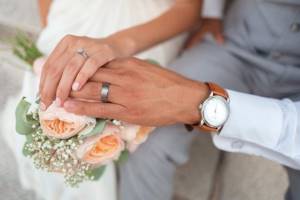
At an Armenian wedding, it is customary to give gold jewelry and money. During the feast, guests wish a calm and long family life, as well as health and happiness to the newlyweds. The mother of the bride presents the cavor as a gift with a large dish with traditional food, and the newlyweds are given a symbol of the eternal tree of continuation of life. At a wedding, Armenians usually have a lot of fun and dance. Only one mother of the bride does not dance, who is saddened by the fact that her daughter left her father’s house forever to join her husband’s family.
The dance of the bride and groom at an Armenian wedding is, as a rule, performed infrequently. However, there is such an interesting custom: the bride dances with other guys. This is how her loyalty is tested. If during the dance the young wife does not pay attention to this or that man, he, as a sign of respect for her fidelity, gives her gifts. After the wedding, the groom’s mother meets the young family, throws lavash on their shoulders, and treats them with honey so that family life is sweet. To ensure that there is an abundance in the house, the newlyweds are showered with raisins, sweets, nuts, grains and flowers.
Carrying out an Armenian wedding
In Armenia, a wedding without a wedding is not recognized, so this ceremony is mandatory for a young couple. It is very important that no one passes between the newlyweds during the process.
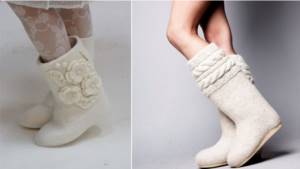
During the wedding, one of the Cavors must hold a crossed sword and scabbard over the heads of the couple. This ritual is associated with the fact that metal protects the couple from evil spirits. It is worth mentioning another important and quite interesting ritual.
During the ceremony, the priest tied special cords on both the bride and groom's hands (sometimes necks), the ends of which were covered with wax. This cord has a name - narot. No one except a clergyman can remove it independently. This action did not allow the spouses to have close relationships; they had to wait until the cord was untied. After the main event, the wedding, comes the official part of the celebration - the wedding.
This event requires the newlyweds and their relatives to observe a huge number of rituals that help the couple to be happy in marriage.
The wedding took place in two houses, and it began in the morning. In the groom's house, a bull was traditionally slaughtered, whose neck was decorated with apples. During this action, young girls sang songs and danced.
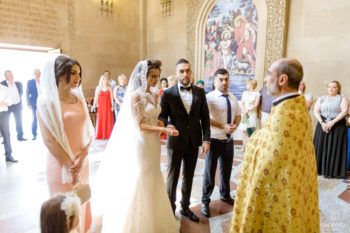
The kavor smeared the groom's forehead with fresh blood. The boy's mother had to take a thread and soak it in this blood. The thread was kept until the wedding night.
Armenians associate such an unusual ritual with childbirth, since the bull itself serves as a symbol of fertility. The newlyweds are greeted by their mother-in-law in the house of their future spouse. She gives the bride and groom a spoonful of honey and places lavash on their shoulders. When the newlyweds enter the house, they are sprinkled with raisins and flowers from baskets. This custom gives young people a prosperous and peaceful life.
In the bride's house there is a big feast, toasts are made, and music is played.
But the musical accompaniment has a sad motive, since the girl’s parents are saddened that their now adult daughter is leaving her home. At the end of the feast, the bride and groom dance. At the end of the dance, the girl’s father joins the hands of the young couple and blesses the couple.

After this, everyone returns to the groom’s house, where most of the entire celebration in honor of the birth of a young family takes place. The bride's brother tries to prevent the couple from leaving the house, thereby protesting and wanting the sister to stay in this house.
Cavor comes to an agreement with his brother and gives him a bride price. It is impossible to say unequivocally that the wedding traditions of the people belong only to Armenians, because their festive rituals are mixed with the rituals of other peoples. It is worth noting that the Armenian feast began with toasts, which honored the memory of deceased relatives. After this, it was only possible to congratulate the newlyweds and make toasts in their honor.
According to old customs, the bride was not given a place at the table; she stood in the corner behind a beautiful curtain, surrounded by a large number of amulets and amulets.
Now, of course, the wedding takes place in a more civilized manner, and the bride sits at the wedding table next to her newly-made husband.
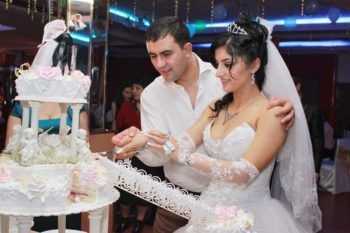
The holiday was accompanied by cheerful songs and dances. During the celebration, the guests presented the newlyweds with gifts and money.
The guests who represented the groom's side had fun from the heart, thereby expressing their joy that their groom had found such a wonderful bride. The bride's relatives were more reserved because they were sad and sad that the bride was leaving her father's house. Modern Armenian traditions are no longer much different from those to which we are accustomed. But still, some rituals were preserved and passed on from generation to generation.
An experienced toastmaster who is well versed in national traditions is invited to the celebration.
Ritual of confirmation of the virginity of a young wife
This custom is no longer mandatory. The issue of observing this tradition is discussed in advance between the relatives of the newlyweds. If after the first wedding night the responsibility and honesty of the bride has been proven, then the groom gives her a red apple decorated with silver coins, and sends a red gift to the mother of the young wife as a sign of gratitude for raising her daughter. This could be a basket of bright red apples, a bottle of cognac with a red ribbon or red wine, or a fresh chicken carcass. As a result, we can conclude that the original Russian and Armenian wedding customs with their bright national flavor are very similar to each other. Although in Armenia traditions are observed more strictly, and they have been preserved in the form that existed several centuries ago.
Interesting traditions
Of course, great importance was attached to the bride's chastity, as a sign of which her mother received gifts from the new matchmaker . Previously, it was slaughtered chicken, red apples, wine or cognac. Nowadays, the matchmaker is usually given only a basket of red apples.
The absence of such a gift was considered a great shame for the family, since she was unable to preserve her daughter’s chastity and, as a result, give her a good upbringing. Of course, in the modern world this fact is not viewed so critically, however, they try to follow traditions.
Regarding the ring on my left hand. They explain this by saying that this way the wedding ring is closer to the heart, and as a result the marriage is much stronger. Although usually Orthodox Christians wear a ring on their right hand, since this tradition dates back to the founding of the church and has received a lot of confirmation in the form of icons that depict the wedding of Mary. Although, as modern practice has shown, which hand the ring is worn on is everyone’s free choice.
However, Armenians are a distinctive culture, so they wear a ring on their left hand. Historians have not yet determined the origins of this tradition. Indeed, besides the fact that the ring is worn on the left hand, their wedding rites are practically no different from other Orthodox Christians.
It is also worth noting that a wedding in Armenia is a holiday for all relatives and neighbors, and in some cases for the whole village. The celebration is held on a very large scale. This tradition continues to this day. Previously, depending on the number of village residents, even before reaching adulthood, parents had already begun to save money and stock up on wine and cognac for the wedding.
Therefore, when the time came, the wedding took place on such a scale that it is difficult for residents of modern cities to even imagine. After all, not only all residents of the village were invited, but also relatives from other countries came. Therefore, the fun turned out to be simply grandiose. After all, the bride’s parents were happy that their daughter was getting married. Accordingly, the groom's parents were happy that their son had become an adult and started his own family. Therefore, nothing was spared to celebrate the wedding.
Spring wedding: May
A little history
Urartu is a state located on the Armenian Highlands in IX BC. e. Undoubtedly, the combined multitude of tribes had their own distinctive costume features, but, unfortunately, information about them has not been preserved.
Following the Urartian kingdom in 189 BC. e. The Artashesid kingdom came, uniting the vast majority of people who consider Armenian their native language. The art of craftsmen quickly grew in Armenia, market relations developed with Iran, the Indian peoples and the Chinese, cities near the Mediterranean and Black Seas, and all this influenced the attire of the inhabitants of sunny Armenia.
The baptism of the state drew Armenia into confrontation with Byzantium. Very little knowledge has been preserved about folk costume during this period, but it is known for certain that the nobility preferred the outfits of the Persian court, while the rest of the population dressed quite casually.
During the period of Arab influence (640-885), part of the merchant class and princes adopted some details of Arab clothing. 1080-1375 introduced details of European costumes into the folk costume of Armenia. The Tatar-Mongol raids of the 13th-14th centuries also did not leave the national clothes of the Armenians unchanged. During the Persian Wars, three-quarters of Armenia was captured by the Ottoman Empire, but the remaining lands were still under the control of Iran, which, in turn, also had its influence.
Thus, the suit, passing through time, wars and times of peace, times of growth and decline, borrowing and giving, took on its own unique appearance.
Matchmaking in Armenian
Armenian matchmaking is an important stage of preparation for a wedding. Now it is more of a playful nature, but the solemnity and thoroughness of the event has hardly changed. After the young man has told his betrothed about his intentions and received consent to the wedding, he must tell the news to his mother. The groom's mother conveys the good news to her husband, who will immediately begin searching for matchmakers, as well as preparing matchmaking.
Matchmakers can be women or men, and they must be accompanied by an intermediary who is familiar with both families. The girl's family also carefully prepares for the arrival of the groom's envoys - the father and mother call several close relatives and set the table. When the matchmakers arrive, there is a conversation between the families without any hint of the real purpose of the visit - about the weather, nature, health, politics. Then the mediator or one of the messengers says:
“We ask for your daughter’s hand in marriage to our man.”
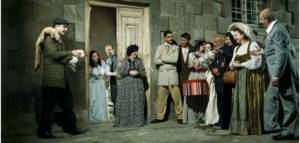
Sometimes relatives do not hesitate to use more poetic expressions:
- We want to take a handful of soil from your garden.
When they first arrive, it is customary to refuse matchmakers. Only after the second or even third visit, the father and mother of the bride, having secured the consent of not only the girl, but all relatives who have a voice in the family, agree to hold the wedding. After this, a bottle of cognac is opened and a luxurious feast begins.
The matchmaking table before Armenian weddings looks interesting:
- Serving begins immediately with the main (mainly meat) dishes - shish kebab, lamb, stuffed poultry.
- Guests are not offered sweets; instead, the table is decorated with fruit.
- The mistress of the house (mother of the bride) always bakes bread or pita bread.
- The dishes used are from expensive dinnerware.
- During the feast they drink strong alcohol, usually vodka or cognac.

Discussions about the upcoming wedding and some pre-wedding events take place over food. Guests say toasts prophesying a happy life for future Armenian spouses after marriage.
Next, according to the tradition of Armenian weddings, the groom’s relatives will have to set the same table (or even better). During the feast, details of the event or issues that were not discussed last time are discussed. A few days after the reception, the head of the groom's family (usually the father) goes to the bride's parents to discuss the engagement day and the invited guests.
Features of Armenian weddings
A traditional Armenian wedding is certainly a magnificent and crowded celebration. Once upon a time, all relatives came to a wedding, even from neighboring areas, cities and villages. And this festivities continued “seven days and seven nights,” which gave rise to a catchphrase that is still used today. The “godfather of the wedding” (“kavor”) played a major role in the birth of a new family. As a rule, a close and respected couple was chosen for “godmother weddings”, who themselves could serve as an example of family happiness. The “godparents” gave the most expensive gift to the young people, and in the future they supported the young couple in all matters like parents.
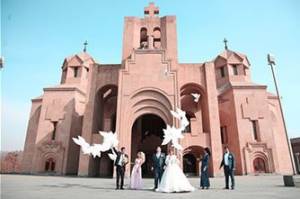
Why is it worth organizing a wedding in Armenia?
Modern couples often organize their wedding celebrations in restaurants or hotel complexes. Many establishments even have special halls designed specifically for wedding celebrations. At the same time, the wedding ceremony often takes place in Etchmiadzin or one of the large capital churches, which in itself is a grandiose and impressive event. And finally, there is one thing the locals cannot be denied – the ability to have fun and “party at a wedding.” Do you want to feel the true spirit of Armenia and make your wedding day special? Then it’s definitely worth holding it here.
